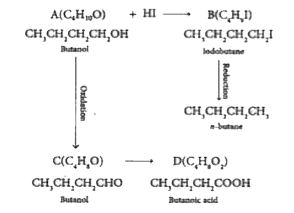An organic compound A (C4H10O) reacts with HI giving a compound B (C4H9I) which on reduction gives n-butane. Oxidation of compound A gives C (C4H8O) and then an acid D (C4H8O2) . Deduce the structure of A,B,C and D.
Topper's Solved these Questions
- ORGANIC COMPOUNDS CONTAINING OXYGEN ATOM BOOK - CENGAGE CHEMISTRYCHAPTER - ORGANIC COMPOUNDS CONTAINING OXYGEN ATOM EXERCISE - OLYMPIAD AND NTSE LEVEL EXERCISES
10 Videos
- ORGANIC COMPOUNDS CONTAINING OXYGEN ATOM BOOK - CENGAGE CHEMISTRYCHAPTER - ORGANIC COMPOUNDS CONTAINING OXYGEN ATOM EXERCISE - CONSOLIDATED EXERCISE (MCQ)
4 Videos
- NOMENCLATURE OF ORGANIC COMPOUNDSBOOK - CENGAGE CHEMISTRYCHAPTER - NOMENCLATURE OF ORGANIC COMPOUNDSEXERCISE - OLYMPIAD AND NTSE LEVEL EXERCISES
10 Videos
- ORGANOHALOGEN COMPOUNDSBOOK - CENGAGE CHEMISTRYCHAPTER - ORGANOHALOGEN COMPOUNDSEXERCISE - OLYMPIAD AND NTSE LEVEL EXERCISES
10 Videos
Similar Questions
An organic compound A (C3H5N) on boiling with alkali gives ammonia and sodium salt of an acid B (C3H6O2). A on reduction gives C(C3H9N) which with nitrous acid gives D (C3H8O). Give the structural formulae of A, B, C and D.
View SolutionOn ozonolysis, an organic compound (A) C6H10 gives two aldehyde (B) C2H4O and (C ) C2H2O2. Determine the structure of A,B and C.
View Solution
Knowledge Check
An organic compound C6)H12(X) on reduction gives C6H14(Y). X on ozonolysis gives two aldehydes C2H4O(I)andC4H8O(II). Identify the compounds X, Y and aldehydes (I) and (II).
AX=CH3CH=CHCH2CH2CH3,Y=CH3(CH2)4CH3,(I)=CH3CHO,(II)=CH3(CH2)2CHOBX=CH3CH2CH=CHCH2CH3,Y=CH3(CH2)4CH3,(I)=CH3CHO,(II)=CH3CHOCX=CH3CH2CH2CH=CH2,Y=CH3(CH2)4CH3,(I)=HCHO,(II)=CH3(CH2)2CHODX=CH3(CH2)3CH3,(I)=CH3CHO,(II)=CH3CH2CHOAn organic compound C6H12(X) on reduction gives C6H14(Y). X on ozonolysis gives two aldehydes C2H4O(I)andC4H8O(II). Identify the compounds X, Y and aldehydes (I) and (II).
AX=CH3CH=CHCH2CH2CH3,Y=CH3(CH2)4CH3,(I)=CH3CHO,(II)=CH3(CH2)2CHOBX=CH3CH2CH=CHCH2CH3,Y=CH3(CH2)4CH3,(I)=CH3CHO,(II)=CH3CHOCX=CH3CH2CH2CH=CH2,Y=CH3(CH2)4CH3,(I)=HCHO,(II)=CH3(CH2)2CHODX=CH3(CH2)3CH3,(I)=CH3CHO,(II)=CH3CH2CHO
An organic compound A (C7H6Cl2) on treatment with NaOH solution gives another compound B (C7H6O). B on oxidation gives and acid C (C7H6O2) which on treatment with a mixture of conc. HNO3 and H2SO4 gives a compound D (C7H5NO4). B on treatment with conc. NaOH gives a compound E (C7H8O) and C6H5COONa. Deduce the structures of [A], [B], [C], [D] and [E].
View SolutionAn organic compound 'A'(C4H10O) is optically active. On mild oxidation, it gives a compound 'B'(C4H8O) but upon vigorous oxidation, it gives another compound 'C'(C3H6O2). The compound 'C' along with 'D' are also formed from 'B' by reacting with iodine in the presence of alkali. Deduce the structures of 'A','B','C' and 'D'.
View SolutionAn organic compound 'A'(C4H10O) is optically active. On mild oxidation, it gives a compound 'B'(C4H8O) but upon vigorous oxidation, it gives another compound 'C'(C3H6O2). The compound 'C' along with 'D' are also formed from 'B' by reacting with iodine in the presence of alkali. Deduce the structures of 'A','B','C' and 'D'.
View SolutionAn organic compound A(C4H8N2) on hydrolysis in acidic medium gives another compound B(C4H9O2N). B forms zwitter ion and gives off CO2 with NaHCO3. B on heating gives compound C(CH4H7ON).LiAlH4 in ether reduces C to pyrolidine. Identify compounds A,B,C.
View SolutionA compound [A] of molecular formula C4H9Br yields a compound [B] of molecular formula C4H10O when reated with aqueous NaOH. On oxidation [B] gives a ketone [C]. The vigorous oxidation of ketone gives ethanoic acid. Deduce the structure of A, B and C.
View SolutionAn organci compound C6H4O2NCl(A) reacts with a,la,oo tp gove C6H5O3N(B). On reduction with tin and HCl,(B) gives C6H7ON(C) whereas on milder reduction it gives (D)C6H7O2N, which rearranges in the presence of a mineral acid to give a new compound (E). Identify the various compounds from (A), to (E).
View Solution

